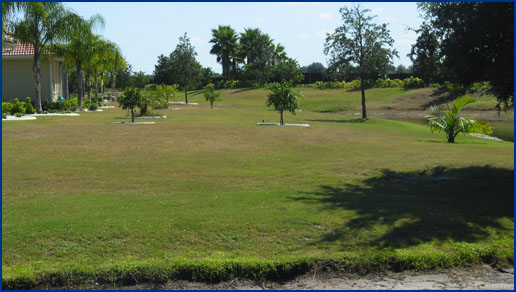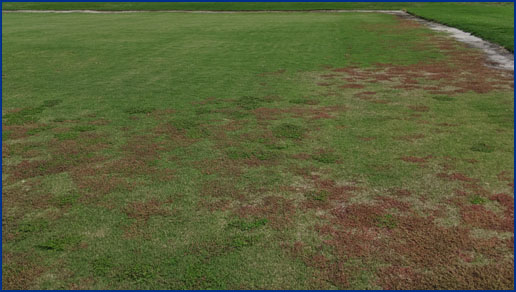Collecting nematode samples from golf course turf
A sample must consist of multiple cores. Nematodes are not evenly distributed in soil, but rather are clumped in distribution. A nematode population density may be high at one spot and low just a few feet way. By collecting multiple cores with a T-type soil probe or similar device, an average population density can be measured. A cup-cutter core is often adequate for a disease diagnosis, but not for nematode diagnosis. A good rule of thumb is to collect 16–20 ½-inch-diameter cores per area (green, fairway, etc.).
If damage is evident, then sample near the margin of affected areas. Nematode populations will decline in severely damaged areas because they have nothing left to eat. Do not take samples from dead areas. Try to sample turf that is declining, but not dead. When taking samples from turf that is not yet showing above-ground symptoms, or if sampling before planting, sample in a zig-zag pattern across the area.

Put the soil from each sampled area into a plastic bag and seal the bag to preserve the soil moisture. (Sampling for nematodes is different from sampling for nutrient analysis, where dry soil is preferred. Nematodes require moisture to survive, so drying the soil will kill them.) Make sure that each bag is labeled with a permanent marker so that the diagnosis can be assigned to the correct area. If you use a ziplock type bag, seal it with tape because the zippers often come open in transit.
Handle samples carefully and do not expose them to direct sunlight or heat. Nematodes are sensitive to high temperatures and UV light. Leaving samples on the dashboard of your car or in the back of a golf cart for periods of time can kill them quickly and make it impossible to accurately diagnose your problem. It is best to keep the nematodes samples in an air-conditioned room until shipping. For shipping and transport, pack the samples well to minimize shifting.

Submit the sample right away. Next-day delivery is best. One study found greatest nematode recovery from hand-delivered samples, the next highest from next-day delivery, and the lowest from regular postal delivery. Ship samples early in the week so that they will not sit in a warehouse or on a truck over the weekend.
Root-knot nematodes are very damaging to golf greens in Florida. Soil extraction is not very accurate for diagnosis of these nematodes, so the University of Florida Nematode Assay Lab has a separate procedure for diagnosis of root-knot nematodes from golf greens. Using a 1.5-inch-diameter or larger device collect four 2-inch-deep turf plugs from symptomatic areas on the green and place into a plastic bag. Shipping and handling are then as described above.
Link for collecting nematode samples for soil extraction:
https://www.youtube.com/watch?v=frVnM5NpsGY
Link for collecting nematode samples for mist extraction:
https://www.youtube.com/watch?v=Fk1sAcwC760&t=8s

